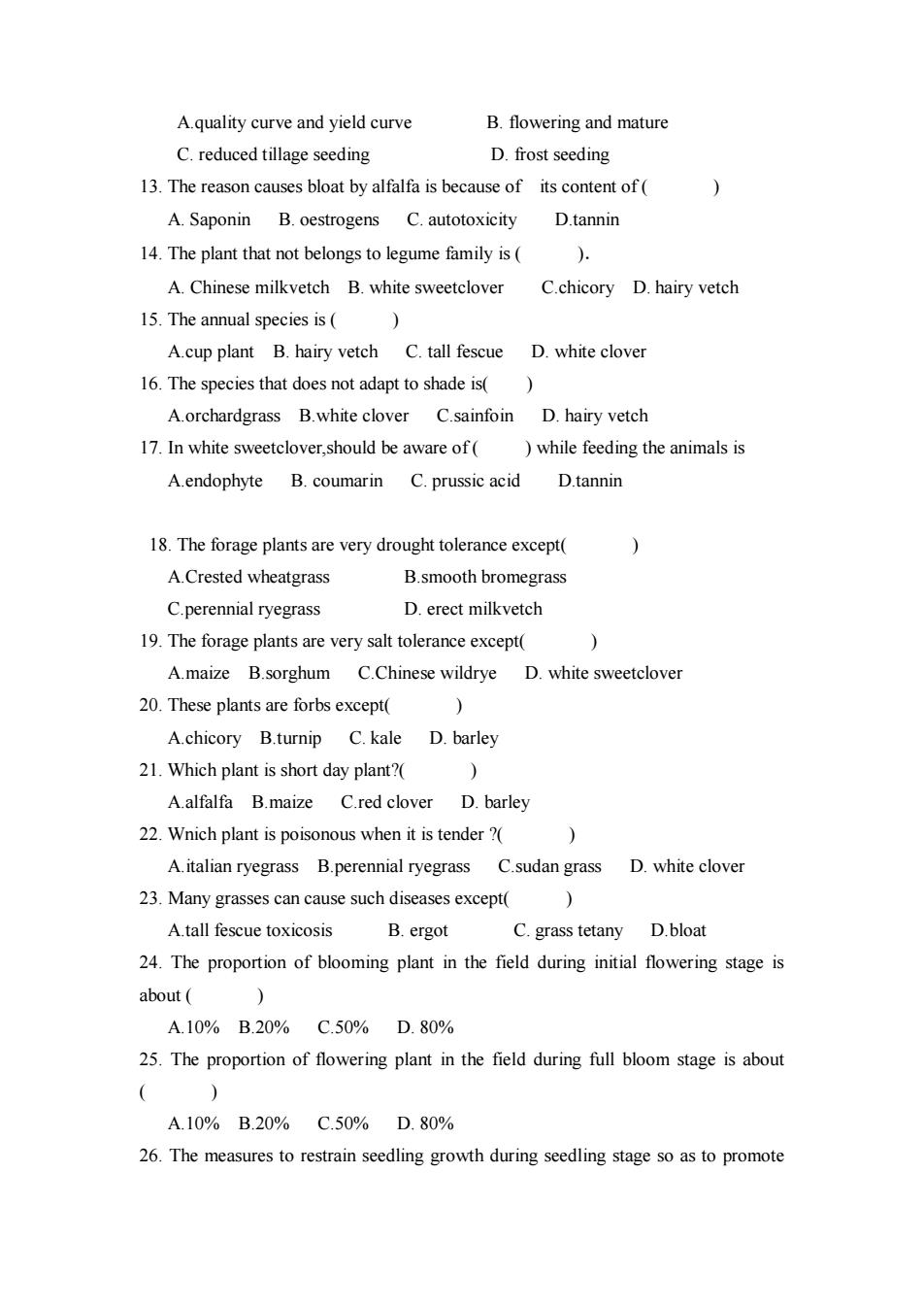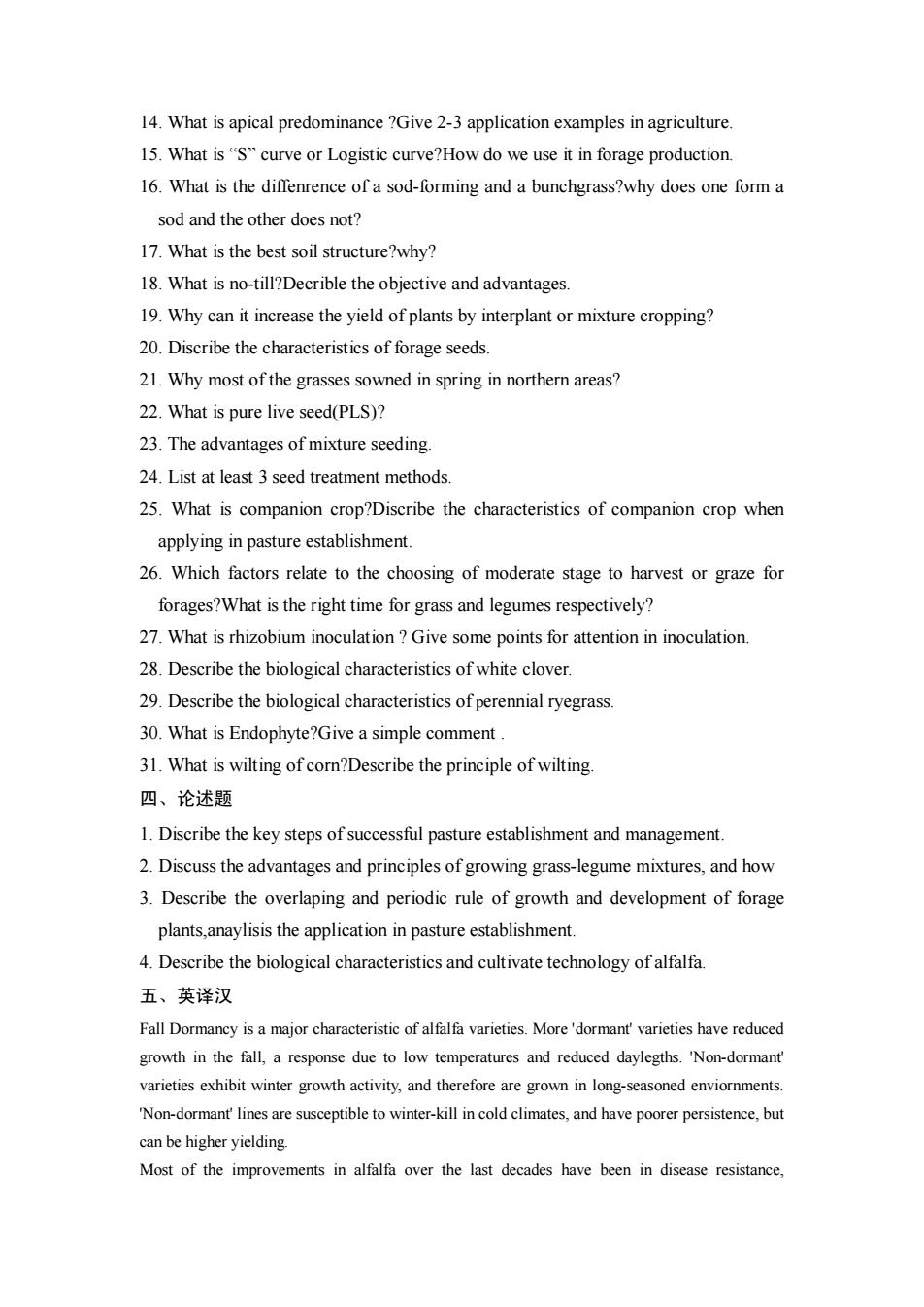
一、填空题 1.在图下横线上填出相应部位英文名称 GRASSES ystem (2) root system (10) (1)(2) (3) (4) (5) (6) (7) (8) (9) (10) 2.在横线上填出下列相应拉丁名称前的序号 紫花苜蓿_ 白三叶 小冠花 毛苕子 草木樨 多年生黑麦草 草地早熟禾 苇状羊茅 无芒雀麦 玉米 (1)Festuca arundinacea Schreb.(2)Vicia villosa Roth (3)Lolium perenne L. (4)Trifolium repens L. (5)Melilotus suaveolens Ledeb.(6)Zea mays L. ()Bromus inermis leyss.(8)Coronilla varia (9)Medicago sativa L. (10)Poa pratensis L
一、填空题 1.在图下横线上填出相应部位英文名称 (1) system (2) root system (1) (2) ( 3) (4) (5) (6) (7) ( 8) (9) (10) 2.在横线上填出下列相应拉丁名称前的序号 紫花苜蓿 白三叶 小冠花 毛苕子 草木樨 多年生黑麦草 草地早熟禾 苇状羊茅 无芒雀麦 玉米 (1) Festuca arundinacea Schreb. (2) Vicia villosa Roth (3) Lolium perenne L. (4) Trifolium repens L. (5) Melilotus suaveolens Ledeb.(6) Zea mays L. (7) Bromus inermis leyss. (8) Coronilla varia (9) Medicago sativa L. (10) Poa pratensis L

二、单项选择题 1.Inhibiting effect of a terminal bud upon the development of lateral buds is called A.apical predominance B.defoliation C.polar growth D.dwarf 2.The most active radiation which is refered to as photosynthetically active radiation(PAR)in photosynthesis in the visble range,is( A200-300nmB.300-400nmC.400-700nmD.700-800nm 3.The important enviorment factor that relates to the vernalisation is( A.light B.temperature C.water D.nutrition 4.Among the 17 essential elements for plant growth,the three essential fertilizer elements are( A.C,H,O B.N,P.K C.Ca,Mg,S D.C,N,K 5.The best soil structure is( A.block B.platy C.columna D.Granular 6.The lowest sowing temprature for maize is( A.3-5℃B.5-8℃C.10-12℃D.20-22℃ 7.Which plant should not be used as a green manuring?( ). A.Chinese milkvetch B.white sweetclover C.sudan grass D.hairy Vetch 8.Grasses are members of( A.poaceae family B.leguminosae plant family C.diocotyledonous D.mostly woody 9.Suppose the percent germination of alfalfa seed is 95%and the purity is 80%,1.5 kg/mu seeding rate of 100%germination,then the actual required seeding rate should be( A.1.33 kg/mu B.1.5 kg/mu C.1.97 kg/mu D.2.65 kg/mu 10.The useful spring seeding method to capture more soil moisture in northern area is () A.companion crop seeding B.no-till seeding C.reduced tillage seeding D.frost seeding 11.The crop that should not be used as a companion crop is( A.spring oat B.barley C.ryegrass D.rye 12.The best time to harvest or graze of forages is the crosspoint of(
二、单项选择题 1. Inhibiting effect of a terminal bud upon the development of lateral buds is called ( ). A. apical predominance B.defoliation C. polar growth D. dwarf 2. The most active radiation which is refered to as photosynthetically active radiation(PAR) in photosynthesis in the visble range, is ( ) A.200300 nm B. 300400 nm C. 400700 nm D. 700800 nm 3. The important enviorment factor that relates to the vernalisation is ( ) A. light B. temperature C. water D.nutrition 4. Among the 17 essential elements for plant growth,the three essential fertilizer elements are( ) A.C,H,O B.N,P,K C.Ca,Mg,S D.C,N,K 5. The best soil structure is( ) A. block B.platy C.columna D. Granular 6. The lowest sowing temprature for maize is ( ). A.35℃ B.58℃ C.1012℃ D. 2022℃ 7. Which plant should not be used as a green manuring? ( ). A. Chinese milkvetch B. white sweetclover C.sudan grass D. hairy Vetch 8. Grasses are members of ( ) A. poaceae family B.leguminosae plant family C.diocotyledonous D.mostly woody 9. Suppose the percent germination of alfalfa seed is 95% and the purity is 80%,1.5 kg/mu seeding rate of 100% germination, then the actual required seeding rate should be( ) A.1.33 kg/mu B. 1.5 kg/mu C. 1.97 kg/mu D. 2.65 kg/mu 10. The useful spring seeding method to capture more soil moisture in northern area is ( ) A.companion crop seeding B.notill seeding C. reduced tillage seeding D. frost seeding 11. The crop that should not be used as a companion crop is ( ) A.spring oat B. barley C.ryegrass D.rye 12. The best time to harvest or graze of forages is the crosspoint of ( )

A.quality curve and yield curve B.flowering and mature C.reduced tillage seeding D.frost seeding 13.The reason causes bloat by alfalfa is because of its content of( A.Saponin B.oestrogens C.autotoxicity D.tannin 14.The plant that not belongs to legume family is A.Chinese milkvetch B.white sweetclover C.chicory D.hairy vetch 15.The annual species is A.cup plant B.hairy vetch C.tall fescue D.white clover 16.The species that does not adapt to shade is() A.orchardgrass B.white clover C.sainfoin D.hairy vetch 17.In white sweetclover,should be aware of( )while feeding the animals is A.endophyte B.coumarin C.prussic acid D.tannin 18.The forage plants are very drought tolerance except( A.Crested wheatgrass B.smooth bromegrass C.perennial ryegrass D.erect milkvetch 19.The forage plants are very salt tolerance except( A.maize B.sorghum C.Chinese wildrye D.white sweetclover 20.These plants are forbs except( A.chicory B.turnip C.kale D.barley 21.Which plant is short day plant?( ) A.alfalfa B.maize C.red clover D.barley 22.Wnich plant is poisonous when it is tender? A.italian ryegrass B.perennial ryegrass C.sudan grass D.white clover 23.Many grasses can cause such diseases except( A.tall fescue toxicosis B.ergot C.grass tetany D.bloat 24.The proportion of blooming plant in the field during initial flowering stage is about( A.10%B.20%C.50%D.80% 25.The proportion of flowering plant in the field during full bloom stage is about ( A.10%B.20%C.50%D.80% 26.The measures to restrain seedling growth during seedling stage so as to promote
A.quality curve and yield curve B. flowering and mature C. reduced tillage seeding D. frost seeding 13. The reason causes bloat by alfalfa is because of its content of ( ) A. Saponin B. oestrogens C. autotoxicity D.tannin 14. The plant that not belongs to legume family is ( ). A. Chinese milkvetch B. white sweetclover C.chicory D. hairy vetch 15. The annual species is ( ) A.cup plant B. hairy vetch C. tall fescue D. white clover 16. The species that does not adapt to shade is( ) A.orchardgrass B.white clover C.sainfoin D. hairy vetch 17. In white sweetclover,should be aware of ( ) while feeding the animals is A.endophyte B. coumarin C. prussic acid D.tannin 18. The forage plants are very drought tolerance except( ) A.Crested wheatgrass B.smooth bromegrass C.perennial ryegrass D. erect milkvetch 19. The forage plants are very salt tolerance except( ) A.maize B.sorghum C.Chinese wildrye D. white sweetclover 20. These plants are forbs except( ) A.chicory B.turnip C. kale D. barley 21. Which plant is short day plant?( ) A.alfalfa B.maize C.red clover D. barley 22. Wnich plant is poisonous when it is tender ?( ) A.italian ryegrass B.perennial ryegrass C.sudan grass D. white clover 23. Many grasses can cause such diseases except( ) A.tall fescue toxicosis B. ergot C. grass tetany D.bloat 24. The proportion of blooming plant in the field during initial flowering stage is about ( ) A.10% B.20% C.50% D. 80% 25. The proportion of flowering plant in the field during full bloom stage is about ( ) A.10% B.20% C.50% D. 80% 26. The measures to restrain seedling growth during seedling stage so as to promote

root growth include these except( A.less irrigate B.control nutrients C.more intertill D.no intertill 27.Maize is domesticated in which part in the world initially? A.Asia B.Europe C.Mesoamerica D.Africa 28.Which country produces almost half of the world's harvest? A.United States B.China C.Brazil D.Mexico Africa 29.Choose the correct description about maize( A.maize is a long day plant B.maize is shade tolerance C.maize is a cross pollination crop D.maize is a self pollination crop 30.Which description about alfalfa is wrong?( A.alfalfa is a long day plant B.alfalfa is a C plant C.alfalfa is a cross pollination crop D.alfalfa can tolerate waterloging 31.If alfalfa is introduced from south to north in China,then the ripening stage might be( A.postponed B.advanced C.unchanged D.unsure 32.Which type of cor is most ofen used for animal feeding? A.flint comn B.dent corn C.sweet corn D.popcorn 33.The fertilizer critical period of com is( A.trefoil stage B.big horn period C.sweet corn D.popcorn 34.For maize culture,phosphate fertilizer should be used as( A.basal fertilizer B.seed fertilizer C.top dressing D.green manure 35.For maize culture,more than half of nitrogen fertilizer should be used at( A.seedling stage B.heading stage C.flower stage D.ripening stage 36.Smooth brome grass is( A.perennial and prostrate B.perennial and erect C.biennial and prostrate D.biennial and erect 37.White clover is( A.perennial and prostrate B.perennial and erect C.biennial and prostrate D.biennial and erect 38.Italian ryegrass is( A.perennial and prostrate B.perennial and erect C.annual and prostrate D.annual and erect 39.Perennial ryegrass is adapt to such environment conditions( A.cold B.drought C.warm and moist D.warm and dry
root growth include these except( ) A.less irrigate B.control nutrients C.more intertill D. no intertill 27. Maize is domesticated in which part in the world initially? A.Asia B.Europe C. Mesoamerica D. Africa 28. Which country produces almost half of the world's harvest? A.United States B. China C. Brazil D. Mexico Africa 29. Choose the correct description about maize( ) A.maize is a long day plant B.maize is shade tolerance C.maize is a cross pollination crop D. maize is a self pollination crop 30. Which description about alfalfa is wrong?( ) A.alfalfa is a long day plant B.alfalfa is a C3 plant C. alfalfa is a cross pollination crop D. alfalfa can tolerate waterloging 31. If alfalfa is introduced from south to north in China,then the ripening stage might be( ) A.postponed B.advanced C.unchanged D.unsure 32. Which type of corn is most often used for animal feeding? A.flint corn B. dent corn C.sweet corn D.popcorn 33. The fertilizer critical period of corn is ( ) A.trefoil stage B. big horn period C.sweet corn D.popcorn 34. For maize culture,phosphate fertilizer should be used as ( ) A.basal fertilizer B.seed fertilizer C.top dressing D.green manure 35. For maize culture,more than half of nitrogen fertilizer should be used at ( ) A.seedling stage B.heading stage C. flower stage D.ripening stage 36. Smooth brome grass is ( ). A.perennial and prostrate B. perennial and erect C.biennial and prostrate D. biennial and erect 37. White clover is ( ) A.perennial and prostrate B. perennial and erect C.biennial and prostrate D. biennial and erect 38. Italian ryegrass is( ) A.perennial and prostrate B. perennial and erect C.annual and prostrate D. annual and erect 39. Perennial ryegrass is adapt to such environment conditions( ) A.cold B. drought C.warm and moist D.warm and dry

40.Alfalfa is adapt to such environment conditions( A.acid soil B.waterloging C.warm and moist D.warm and dry 41.The long day plant is( A.maize B.barley C.sorghum D.soybean 42.These plants are top grass except( A.alfalfa B.white clover C.Chinese wildrye D.smooth brome grass 43.The plant that does not cause bloat is () A.alfalfa B.white clover C.red clover D.sainfoin 44.Ryegrass often can can cause A.tall fescue toxicosis B.ergot C.grass tetany D.bloat 45.Which description about ryegrass is correct? A.cold tolerance B.heat tolerance C.like fertile soil D.bad regrowth 三、简答题 1.Therefore,it is not appropriate to irrigate during seedling stage so as to promote root growth and decease rate of death. 2.Explain the importance of the soil-plant-animal biological system and its significance to human health and well-being? 3.What is the role of forage as an overall source of feed for livestock? 4.Why are forages undervalued in the overall system? 5.What region of solar spectrum is the most important for plant growth?Why? 6.How would change in latitude influnce flowering and petential seed production of a long-day grass species?Would responses be similar for a day-neutral species? 7.Why is knowing the growth stages when minimum and maximum organic reserves occur important to the management of perennial and biennial species? ce to human health and well-being? 8.What is the external condition requirements for seed germination? 9.What is a Phytomer? 10.What is tiller ?Describe the main factors that affect tillering. 11.List the main development stages of Grasses and Legumes orderly 12.List the factors that related to plant growth and development 13.What is Photoperiodism?List the three types plants and give two example plants respectively
40. Alfalfa is adapt to such environment conditions( ) A.acid soil B.waterloging C.warm and moist D.warm and dry 41. The long day plant is ( ) A.maize B.barley C.sorghum D.soybean 42. These plants are top grass except( ) A.alfalfa B.white clover C.Chinese wildrye D.smooth brome grass 43. The plant that does not cause bloat is ( ) A.alfalfa B.white clover C.red clover D.sainfoin 44. Ryegrass often can can cause ( ) A.tall fescue toxicosis B. ergot C. grass tetany D.bloat 45. Which description about ryegrass is correct? ( ) A.cold tolerance B.heat tolerance C.like fertile soil D. bad regrowth 三、简答题 1.Therefore, it is not appropriate to irrigate during seedling stage so as to promote root growth and decease rate of death. 2.Explain the importance of the soilplantanimal biological system and its significance to human health and wellbeing? 3.What is the role of forage as an overall source of feed for livestock? 4.Why are forages undervalued in the overall system? 5.What region of solar spectrum is the most important for plant growth?Why? 6.How would change in latitude influnce flowering and petential seed production of a longday grass species?Would responses be similar for a dayneutral species? 7.Why is knowing the growth stages when minimum and maximum organic reserves occur important to the management of perennial and biennial species? ce to human health and wellbeing? 8. What is the external condition requirements for seed germination? 9. What is a Phytomer? 10. What is tiller ?Describe the main factors that affect tillering. 11. List the main development stages of Grasses and Legumes orderly. 12. List the factors that related to plant growth and development. 13. What is Photoperiodism?List the three types plants and give two example plants respectively

14.What is apical predominance ?Give 2-3 application examples in agriculture. 15.What is"S"curve or Logistic curve?How do we use it in forage production. 16.What is the diffenrence of a sod-forming and a bunchgrass?why does one form a sod and the other does not? 17.What is the best soil structure?why? 18.What is no-till?Decrible the objective and advantages 19.Why can it increase the yield of plants by interplant or mixture cropping? 20.Discribe the characteristics of forage seeds. 21.Why most of the grasses sowned in spring in northern areas? 22.What is pure live seed(PLS)? 23.The advantages of mixture seeding. 24.List at least 3 seed treatment methods. 25.What is companion crop?Discribe the characteristics of companion crop when applying in pasture establishment. 26.Which factors relate to the choosing of moderate stage to harvest or graze for forages?What is the right time for grass and legumes respectively? 27.What is rhizobium inoculation?Give some points for attention in inoculation. 28.Describe the biological characteristics of white clover. 29.Describe the biological characteristics of perennial ryegrass 30.What is Endophyte?Give a simple comment. 31.What is wilting of corn?Describe the principle of wilting. 四、论述题 1.Discribe the key steps of successful pasture establishment and management. 2.Discuss the advantages and principles of growing grass-legume mixtures,and how 3.Describe the overlaping and periodic rule of growth and development of forage plants,anaylisis the application in pasture establishment. 4.Describe the biological characteristics and cultivate technology of alfalfa 五、英译汉 Fall Dormancy is a major characteristic of alfalfa varieties.Moredormant varieties have reduced growth in the fall,a response due to low temperatures and reduced daylegths.Non-dormant varieties exhibit winter growth activity,and therefore are grown in long-seasoned enviornments Non-dormant lines are susceptible to winter-kill in cold climates,and have poorer persistence.but can be higher yielding Most of the improvements in alfalfa over the last decades have been in disease resistance
14. What is apical predominance ?Give 23 application examples in agriculture. 15. What is “S” curve or Logistic curve?How do we use it in forage production. 16. What is the diffenrence of a sodforming and a bunchgrass?why does one form a sod and the other does not? 17. What is the best soil structure?why? 18. What is notill?Decrible the objective and advantages. 19. Why can it increase the yield of plants by interplant or mixture cropping? 20. Discribe the characteristics of forage seeds. 21. Why most of the grasses sowned in spring in northern areas? 22. What is pure live seed(PLS)? 23. The advantages of mixture seeding. 24. List at least 3 seed treatment methods. 25. What is companion crop?Discribe the characteristics of companion crop when applying in pasture establishment. 26. Which factors relate to the choosing of moderate stage to harvest or graze for forages?What is the right time for grass and legumes respectively? 27. What is rhizobium inoculation ? Give some points for attention in inoculation. 28. Describe the biological characteristics of white clover. 29. Describe the biological characteristics of perennial ryegrass. 30. What is Endophyte?Give a simple comment . 31. What is wilting of corn?Describe the principle of wilting. 四、论述题 1. Discribe the key steps of successful pasture establishment and management. 2. Discuss the advantages and principles of growing grasslegume mixtures, and how 3. Describe the overlaping and periodic rule of growth and development of forage plants,anaylisis the application in pasture establishment. 4. Describe the biological characteristics and cultivate technology of alfalfa. 五、英译汉 Fall Dormancy is a major characteristic of alfalfa varieties. More 'dormant' varieties have reduced growth in the fall, a response due to low temperatures and reduced daylegths. 'Nondormant' varieties exhibit winter growth activity, and therefore are grown in longseasoned enviornments. 'Nondormant' lines are susceptible to winterkill in cold climates, and have poorer persistence, but can be higher yielding. Most of the improvements in alfalfa over the last decades have been in disease resistance

improved ability to overwinter in cold climates.and multileaf traits.Disease resistance is important because it improves the usefuess of poorly drained soils and during e vears. Multileaf alfalfa has more than three leaflets per leaf.These lines may have a higher nutitional content by weight because there is relatively more leafy matter for the same amount of stem
improved ability to overwinter in cold climates, and multileaf traits. Disease resistance is important because it improves the usefulness of alfalfa on poorly drained soils, and during wet years. Multileaf alfalfa has more than three leaflets per leaf. These lines may have a higher nutitional content by weight because there is relatively more leafy matter for the same amount of stem